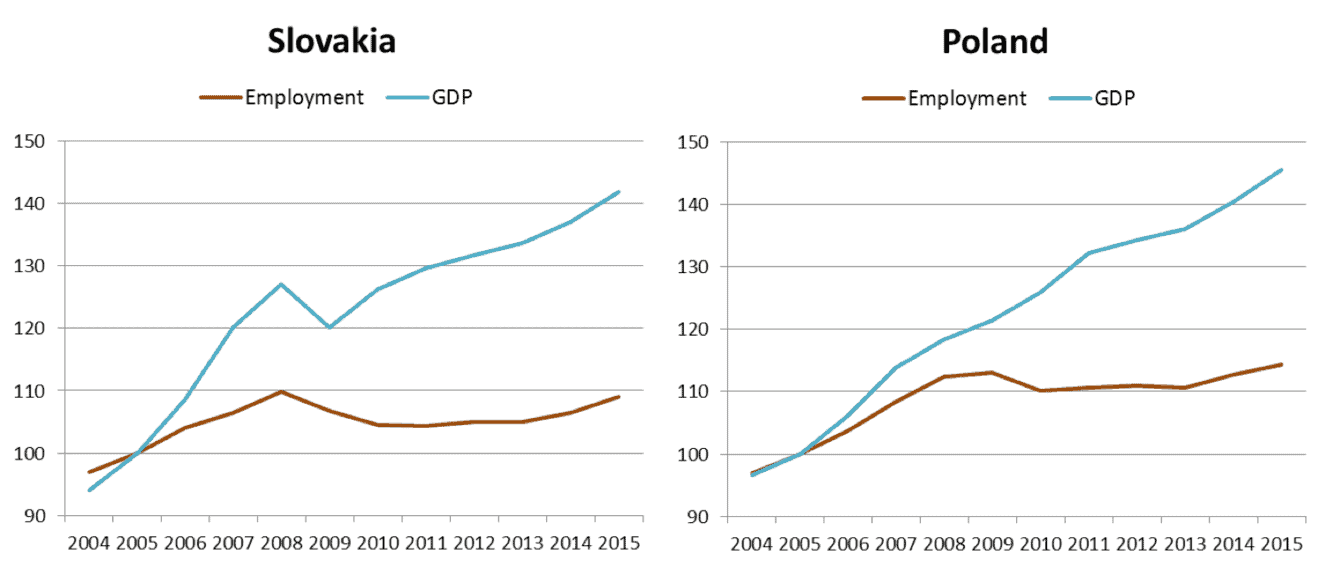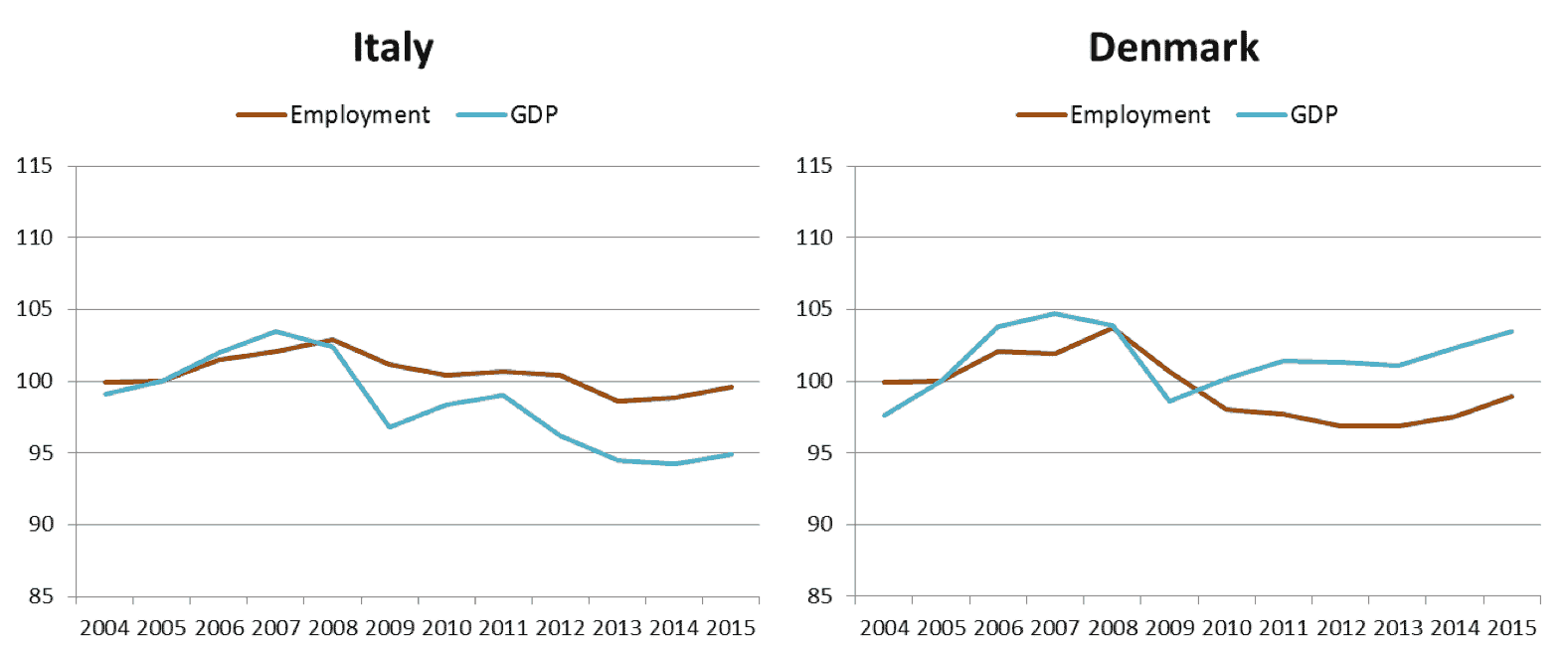
In the years since the 2008 crisis, 229 employment protection reforms have been imposed across EU member states (see here). There has been a strong bias in favour of decreasing employment protection, even to a remarkable extent in some countries. The main argument for these reforms has been that making dismissals easier would encourage employers to hire workers on permanent contracts, therefore reducing unemployment and labour market segmentation.
However, there is no logical reason why this should be the case. Reduced employment protection could just as plausibly lead to more dismissals and a less secure labour force, discouraging training and skill acquisition. Determining which effect predominates should be a matter for empirical research.

The OECD, a leading protagonist of the deregulation argument in recent years, has broadly accepted that ‘flexibility-enhancing’ reforms, which reduce employment protection, have ‘at worst no or a limited positive impact on employment levels in the long run’ (see OECD Employment Outlook). However, it still searches for possible examples to support the old argument. Thus, it quotes Estonia as a case where easier dismissals led to lower unemployment than would otherwise have been the case. But this conclusion takes no account of the country’s economic structure, of changes in investment, of the effects of EU funds, or of the extent of migration. In fact, ‘flexibilisation’ of employment protection in Estonia had no significant impact on employers’ firing behaviour, with most of the post-crisis dismissals taking place before the reforms.
Studying the effects of employment deregulation requires the analysis of detailed case studies across a significant number of countries, taking account as far as possible of the other factors that have a significant impact on employment. The new ETUI book Myths of employment deregulation does just this, with a focus on nine EU member states. The book shows that deregulation was not a significant factor affecting employment levels, and that it was in fact accompanied by increases, rather than cuts, in the numbers of workers in insecure forms of employment.
Reforms do not lead to more jobs
The two examples below show that labour market reforms do not necessarily lead to increased employment. There were 14 employment law reforms made in Slovakia between 2008 and 2014, while Poland saw only one. The OECD’s index of employment protection legislation (a very unreliable indicator, as demonstrated in the book) itself registered a substantial reduction in protection in Slovakia but no change in Poland over the period 2008-2013. However, Figure 1 shows quite similar employment and GDP trends in both countries. Slovakia’s downturn in 2009, reflecting reduced motor vehicle sales during the crisis, was short-lived.

Figure 1: Employment and GDP changes, 2004-2015 (2005=100) (Source: Eurostat)
Another illustrative comparison is that between Italy and Denmark, shown in Figure 2. The latter country had one of the smallest numbers of reforms in the sample (only two between 2008 and 2014). Italy, meanwhile, saw the highest number (42 in the same period). GDP growth followed very similar trends in both countries until Italy was hit by severe austerity measures from 2011, while employment moved closely in line with changes in the levels of economic activity.
Overall, there seems to be no link between employment protection reforms and total employment.

Figure 2: Employment and GDP changes, 2004-2015 (2005=100) (Source: Eurostat)
Low protection means more precarious jobs
The experiences of the nine chosen countries show that other factors were far more important than job protection reforms for employment levels. However, lowering protection for workers has exacerbated the shift towards non-standard forms of employment.
This takes different forms depending on the country (as shown in Figure 3) but, more importantly, the growth in precarious employment has been particularly acute in countries where permanent workers have some of the lowest levels of protection. This is the opposite of what the reforms promised to achieve.

Figure 3: Change in the share of atypical forms of work in total employment, 2008-2015, in percentage points (Source: Eurostat)
Temporary contracts generally declined when jobs were lost as those were the first employees to be dismissed, as was the case in Spain. With post-crisis recovery, atypical forms of employment increased their share in all the countries we analysed. Reduced protection has not encouraged employers to make wider use of permanent contracts, but rather pushed employees to accept less secure forms of employment.
This has in some cases been made easier by changes in the law, for example giving legal sanction to highly casual employment in Italy through a system of vouchers. This has simply made it easier for employers to offer casual rather than permanent contracts. Similarly, so-called ‘work agreements’ for individual tasks, allowing employers to avoid financial and other obligations, spread to cover 16 percent of all employees in Slovakia. The number halved in 2013 when employers were obliged to pay insurance contributions. In Poland, where 32 percent of employment outside agriculture is either in temporary or ‘own-account’ work, the use of commercial rather than employment contracts (allowing the employer to avoid many obligations) now concerns an estimated 13 percent of the labour force. In the UK, the number of ‘zero-hours’ contracts, giving no guaranteed working time or pay, hit a record high of nearly 1 million in 2016, with an estimated 8 percent among those aged 15-24.
Less chance of a permanent job
Nor did more flexibility in labour regulation also make it easier for workers to move into more secure forms of work. As Figure 4 shows, quite the opposite trend can be observed. For workers on temporary contracts it became increasingly difficult to move into a permanent position. In Spain, before the crisis, almost every third temporary worker would have a permanent job by the following year. By 2011 this had dropped to one in ten, with no improvement by 2015. In Slovakia the share of temporary employees who moved into permanent employment fell from 70 percent in 2007 to 30 percent in 2015.

Figure 4: Share of temporary employees who had a permanent job by the following year (Source: Eurostat, EU-SILC)
There have been some legislative changes aimed at curbing precarious employment, but any positive effects were achieved only where this involved increasing protection for casual workers, as illustrated above by the Slovak example.
It is evident that when employers have the upper hand in the labour market, and when laws allow them to use cheaper and more casual forms of employment, the result is a general growth in insecurity. Reduced protection for those on permanent contracts means less security for all.


